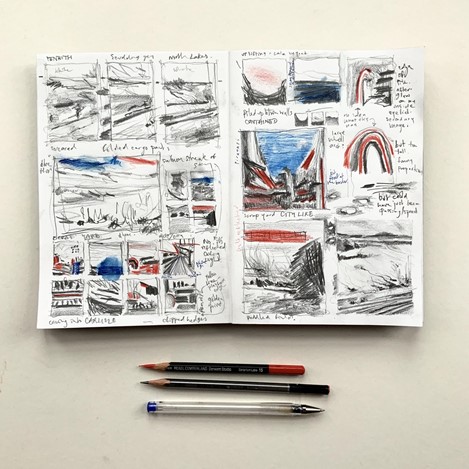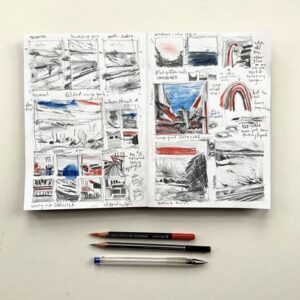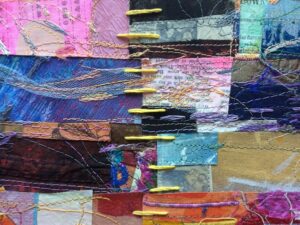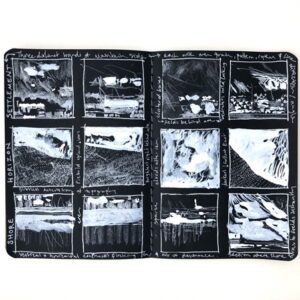
What kind of spatial designer am I? #3 Tansy Hargan, artist.
Studying Interior Design, Spatial Design, Interior Architecture – or any kind of design of the built environment – can lead to many different careers. In this series of blog posts we are looking at the experience and careers of different design professionals and finding out what inspired them to study in the first place.
Our third design professional is Tansy Hargan, who started out studying Architecture before moving on to Landscape Architecture, and now continues her creative career as an artist working predominantly with textiles and drawing.

CB: What first inspired you to practice spatial design?
TH: I had an aunt who was an architect. She was my mum’s sister and I was apparently so like here that my mum often called me by her name. I loved being around her, especially in her home, which was a modern open plan house with a courtyard and mezzanine, filled with her own ceramics and textiles, and her wooden double elephant drawing board, covered with rolled up blueprints and drawings in progress. She always told me architecture was quite a dull job really, but I thought studying it seemed like a good starting point for someone who was good at maths and art, and was constantly making things.
CB: What training and/or experience have you had?
TH: My first concentrated design experience was when I was nine and I visited Italy with my parents. I was one of three, and we never went abroad, but my dad had a conference in Rome and my mum (a dentist) thought it’d be nice to tag along and take me on a sketching trip (my brothers were taken to see Fantasia at the cinema…I think I’d still be bitter if it was the other way round). We visited ancient and renaissance sites in Rome and Naples, and spent a day in Pompeii, drawing and writing as we went. It was the start of an enduring love of Italy, architecture, and en plein air sketching. I gave up art at school when I was 14 because I didn’t have enough options and ended up doing A levels in maths, physics and geography. Luckily, since I’d carried on painting and sewing in my own time, I was able to do architecture when I left school. I loved my degree, but, as predicted by my aunt, I didn’t like the idea of working in an office, so after graduating I took several short courses at art school, such as etching, weaving, and woodcarving. I moved to Ireland in my early twenties and bought an old church, which I restored whilst working as an illustrator for an architect and making my own art. I had a couple of art residencies and small exhibitions, then three babies in my late twenties. Eventually, after ten years away from university, I decided to go back and finish my formal training. I took a masters and diploma in landscape architecture, and worked in ecological design and post industrial regeneration for several years. I became chartered during this time, but found that this milestone pretty much marked the end of hands-on design work. I’m now back to being an almost-full-time artist, teaching a couple of landscape architecture modules a year at the University of Sheffield as an external tutor.
CB: What is your favourite film?
TH: As Good as it Gets (about kindness and redemption).
CB: What is the most exciting interior or exterior space you have created?
TH: A herb garden in Sutton-in-Ashfield. It was the first project I worked on from inception to completion, and involved an intensive consultation process with the elderly community it was created for. The budget was generous and the site was small, compared with most public open space projects I worked on, so I was able to design a well-crafted and richly-planted space.
CB: What is your favourite material to work with?
TH: Old clothing. I unpick them and paint on them, then cut them up and collage with them to make art. There are many parallels between textiles and the processes that shape landscape. Like a river, for example, it erodes silt and reveals what’s beneath to different degrees depending on substrate composition and speed of flow. Or snow falling on undulating land, outlining ridges and melting in furrows, or appearing in varying densities beneath tree canopies and overhanging hedgerows.

CB: Sketching, doodling, modelling or research – where do you start?
TH: I go for a walk. Sometimes I take my sketchbook and draw what I see or make notes, but the important thing is the walk. It resets my mind somehow, frees up space, and allows me to proceed more calmly with purpose.
CB: What is your go-to initial designing tool (pen, pencil, model making, digi visualisation)?
TH: Viewfinder, drawing pen and small sketchbook. The first of these is not only about looking, it’s also about stimulating a visual thought process. Seeing ratios, colour palettes, juxtapositions, design languages and so on in isolation. They can be a useful starting point, especially if you don’t have a client brief and just want to start the ball rolling.
CB: Do you have an all-time favourite building?
TH: St Mark’s Basilica, Venice. I first became enthralled by this building around the age I went to Rome, but through a painting of it by John Bunny that was in the collection of the Guild of St George, held at the Ruskin Gallery in Sheffield. It was warm, richly detailed and jewel-like, and looked like a palace from someone’s imagination. When I eventually visited, aged 20 as an architecture student, I realised the painting showed a glowing basilica not because it was sunny, but because of all the gold. I don’t think I’d really thought beyond the facade as a child, but in real life I found the interior mesmerising. It’s a huge 3D tessellation of marble, glass and gold. I’ve been back many times since and it never fails to make me feel like I’m seeing it fresh.
CB: What one thing would you say to yourself as a young spatial designer starting out?
TH: Use your sketchbook every day and don’t be precious about it; let it become part of your process.
CB: What would you have liked to have known before you started?
TH: It’s ok to change your mind. The skills you gain on a design degree will be valuable whatever you end up doing. Have fun and work hard: it’ll all be fine.
You can find out more about Tansy and her work on her website at https://tansyhargan.com/ and on instagram at https://www.instagram.com/palimpsestparade/

|
|







I was delighted to read this article here – in part because I am currently doing an online course with Tansy on mixed media sketchbook development which I have found really rewarding and supplements my OCA main work very well.
Aha! – glad you enjoyed it; and I’m sure the sketchbook development course is amazing (as both her sketchbooks and process are amazing too). I’m a huge fan and have been for a long time… What are you studying with OCA?
I’m on the textiles pathway at level 2 Catherine. I am really enjoying Tansy’s course. I’m making more use of mixed media in my sketchbook which I think is great for developing ideas in textiles in its widest sense.